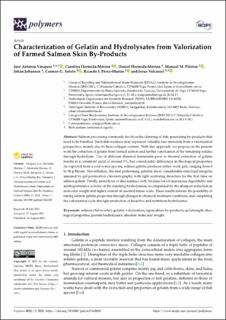| dc.contributor.author | Vazquez, Jose A | |
| dc.contributor.author | Hermida-Merino, Carolina | |
| dc.contributor.author | Hermida-Merino, Daniel | |
| dc.contributor.author | Piñeiro, Manuel M. | |
| dc.contributor.author | Johansen, Johan | |
| dc.contributor.author | Sotelo, Carmen G. | |
| dc.contributor.author | Perez-Martin, Ricardo I. | |
| dc.contributor.author | Valcarcel, Jesus | |
| dc.date.accessioned | 2022-02-21T10:37:03Z | |
| dc.date.available | 2022-02-21T10:37:03Z | |
| dc.date.created | 2021-12-22T14:27:24Z | |
| dc.date.issued | 2021-08-23 | |
| dc.identifier.citation | Vázquez, J. A., Hermida-Merino, C., Hermida-Merino, D., Piñeiro, M. M., Johansen, J., Sotelo, C. G., Pérez-Martín, R. I., & Valcarcel, J. (2021). Characterization of Gelatin and Hydrolysates from Valorization of Farmed Salmon Skin By-Products. Polymers, 13(16), 2828. | en_US |
| dc.identifier.issn | 2073-4360 | |
| dc.identifier.uri | https://hdl.handle.net/11250/2980447 | |
| dc.description.abstract | Salmon processing commonly involves the skinning of fish, generating by-products that need to be handled. Such skin residues may represent valuable raw materials from a valorization perspective, mainly due to their collagen content. With this approach, we propose in the present work the extraction of gelatin from farmed salmon and further valorization of the remaining residue through hydrolysis. Use of different chemical treatments prior to thermal extraction of gelatin results in a consistent yield of around 5%, but considerable differences in rheological properties. As expected from a cold-water species, salmon gelatin produces rather weak gels, ranging from 0 to 98 g Bloom. Nevertheless, the best performing gelatins show considerable structural integrity, assessed by gel permeation chromatography with light scattering detection for the first time on salmon gelatin. Finally, proteolysis of skin residues with Alcalase for 4 h maximizes digestibility and antihypertensive activity of the resulting hydrolysates, accompanied by the sharpest reduction in molecular weight and higher content of essential amino acids. These results indicate the possibility of tuning salmon gelatin properties through changes in chemical treatment conditions, and completing the valorization cycle through production of bioactive and nutritious hydrolysates. | en_US |
| dc.language.iso | eng | en_US |
| dc.publisher | MDPI, Basel, Switzerland | en_US |
| dc.rights | Navngivelse 4.0 Internasjonal | * |
| dc.rights.uri | http://creativecommons.org/licenses/by/4.0/deed.no | * |
| dc.title | Characterization of Gelatin and Hydrolysates from Valorization of Farmed Salmon Skin By-Products | en_US |
| dc.type | Peer reviewed | en_US |
| dc.type | Journal article | en_US |
| dc.description.version | publishedVersion | en_US |
| dc.rights.holder | © 2021 by the authors. | en_US |
| dc.source.pagenumber | 18 | en_US |
| dc.source.volume | 13 | en_US |
| dc.source.journal | Polymers | en_US |
| dc.source.issue | 16 | en_US |
| dc.identifier.doi | 10.3390/polym13162828 | |
| dc.identifier.cristin | 1971516 | |
| dc.relation.project | EC/H2020/773330 | en_US |
| dc.source.articlenumber | 2828 | en_US |
| cristin.ispublished | true | |
| cristin.fulltext | original | |
| cristin.qualitycode | 1 | |

